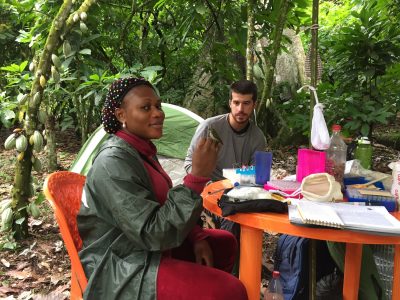Humans destroy the equivalent of one Ireland-sized swath of tropical rainforest every year—mostly due to expansion of agriculture. Cocoa, which fuels the multi-billion dollar chocolate market, is grown in tropical rainforest—mostly in Sub-Saharan Africa on small, family owned farms. African farmers typically cannot afford pesticides, so they rely nature for pest insect removal, but neither farmers nor scientists know which birds and bats provide this service.
Fortunately, cocoa is not nearly as destructive as other crops—it is grown under a lush canopy of rainforest trees, which if managed appropriately, can support biodiversity comparable to that of virgin rainforest. These shade trees also provide habitat for the African birds and bats that undoubtedly save farmers millions of dollars through pest control. Sadly, very little is know about how to manage African cocoa plantations—either for improvement of agricultural production or for the benefit of biodiversity. However, in a technological breakthrough, Biodiversity Initiative scientists are using cutting edge new genetics techniques that allow us to sequence the bits of insect and plant DNA left in birds and bat faeces. This then allows us to map thousands of species in the food web—including shade trees and important pest insects. With this breakthrough, we have the ability to determine:
- Which shade trees benefit birds, bats and farmers via pest insect removal, and
- Which shade trees benefit rainforest biodiversity in general.
Chocolate consumption is rapidly increasing worldwide as the middle class of developing nations swells, thus driving cocoa farms deeper into tropical rainforests to grow their crops. With this novel framework, we will create a system in which African farmers benefit through inexpensive, sustainable management of cocoa, and rainforest animals benefit through the planting of trees that mimic their natural habitat.
More to come soon as this project continues to develop!
Link to popular article on this project (with photos)


